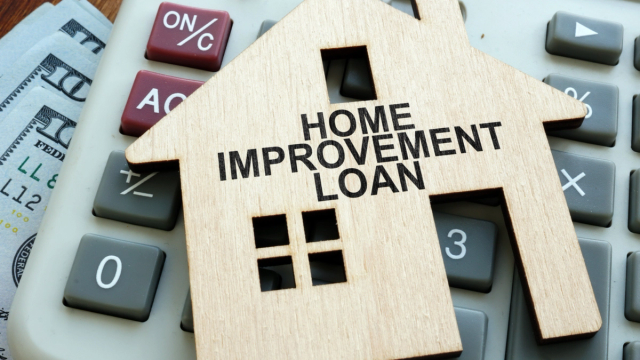Installment Loans: How Do They Work in the Home Improvement Industry?
Installment loans are a straightforward financing solution that offers homeowners payment flexibility and contributes to contractor business growth.

Home repairs and updates are one of the best ways to improve a home’s value, with homeowners spending an average of $10,341 on home improvement projects in 2021. But how are homeowners paying for these projects?
According to Modernize, nearly 14% of surveyed homeowners planned to use a home equity loan or home equity line of credit (HELOC) to finance home improvement projects. Another 13% planned to use a credit card.
While both options can provide homeowners with needed funds, HELOCs require homeowners to use their homes as collateral. Credit cards, meanwhile, can have high interest rates.
Homeowners wanting to avoid both these obstacles may look to another customer financing solution: installment loans. As a home services contractor, understanding this popular payment option is critical for establishing yourself as a trusted consultant during the home improvement process.
What Is an Installment Loan?
Installment loans are fairly straightforward. A lender loans a lump sum of money to a borrower, who then pays back the amount over time in a series of repayments, or installments.
In fact, there’s a good chance you’ve probably used an installment loan before. Mortgages, auto loans, and personal loans are common installment loans, covering a repayment period from as little as six months up to 30 years. Recently, shorter-term installment loans, like “buy now, pay later” plans, are dominating the e-commerce space.
With such a wide variety of use cases and terms, it’s essential to understand how these loans work in the home improvement and HVAC spaces.
Fixed Rate Loans vs. Variable Rate Loans
Installment loans accrue interest, affecting the amount of money repaid in each installment. There are two types of interest rates: fixed and variable.
Fixed interest rates remain the same throughout the life of the loan, resulting in a consistent monthly payment amount. On the other hand, variable interest rates can change over the course of repayment, often impacting the amount repaid in each installment.
What you need to know: most HVAC and home improvement loans are fixed rate loans. That said, checking with your financing partner is always a good idea.
Secured Loans vs. Unsecured Loans
Installment loans can also be secured or unsecured. A secured loan is backed by collateral, an item of value that lenders can seize if the borrower fails to pay back their loan. For example, your home serves as collateral when taking out a mortgage.
Unsecured loans don’t require collateral. Instead, lenders offer loans with interest rates or fees determined by the borrower’s credit score and debt repayment history. Unsecured loans may often have higher interest rates, but they also lack the risk of losing your collateral in the event of non-payment.
Home improvement loans are almost always unsecured, though you will find some lease-purchase or rent-to-own HVAC financing solutions that require homeowners the surrender their equipment if they fail to make payments.
Why Offer Installment Loans?
Since 2019, personal installment loans have risen in popularity — a trend that makes all the more sense when we consider that 1 in 3 Americans have less emergency savings than they did a year ago. As record inflation applies continued pressure to homeowners’ pockets, contractors with alternative payment options are better equipped to handle home improvement sticker shock.
However, homeowner interest in installment loans doesn’t always come down to an inability to pay. Some would simply prefer not to have their liquid cash tied up in a large expense, making the ability to plan around a predictable monthly payment appealing. Homeowners free up more on-hand cash for other priorities, like investing and saving, while you still get paid for the job in full.
For others, installment loans are a great way to improve their credit score. Depending on the homeowner’s credit profile, installment loans can add variety to their credit mix while helping demonstrate their ability to make consistent on-time payments.
Things To Consider Before Offering Installment Loans
As you discuss financing options, there are a few things you should mention to homeowners before they decide to take on an installment loan.
Because installment loans can have longer terms, one of the first things to consider is prepayment penalties. We know, we know: being penalized for paying debt off early hardly seems fair. But it’s not an uncommon practice. While FTL Finance doesn’t penalize homeowners for paying off their loans early, other lenders might.
If you partner with a lender that does, know that the penalty they can charge will include time restrictions under federal law. Ask your financing partner to clearly outline the prepayment penalty schedule. That way, you can be informed should your homeowners have questions.
Even if your homeowner wants a financing solution, installment loans may not be the best fit for their situation. If a homeowner plans on borrowing again for a project soon, they may want to look into a revolving credit solution, like a credit card. Revolving credit allows homeowners to continuously borrow against the same line of credit, while installment loans are one-time deals. Obtaining another installment loan would require another credit check, which could result in a hit on their credit score.
Finally, most lenders have a minimum borrowing amount for installment loans. For example, FTL Finance will finance projects for as low as $300. Larger lending partners may require at least $3,000 for home improvement loans.
The Bottom Line
Installment loans can be a useful solution for financing big-ticket home improvement projects, but you’ll need to understand how and when they can provide the most value to your customers. The good thing is, offering guidance about which financing alternatives make sense for the project won’t require much more work from you. All the information you’ve already gathered for the project proposal will help guide a payment conversation, too.
 Financing EssentialsHome Improvement Loan Types: A Simple Overview for HVAC Contractors
Financing EssentialsHome Improvement Loan Types: A Simple Overview for HVAC Contractors Financing EssentialsSecond-Look Financing: How Does It Benefit Your Home Improvement Business?
Financing EssentialsSecond-Look Financing: How Does It Benefit Your Home Improvement Business? Sales Strategy, Financing Essentials3 HVAC Mistakes That Are Costing You Money
Sales Strategy, Financing Essentials3 HVAC Mistakes That Are Costing You Money